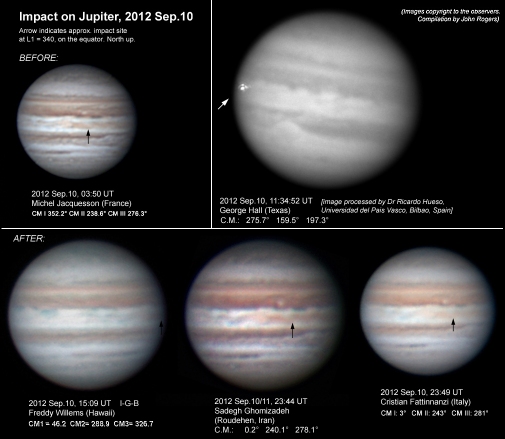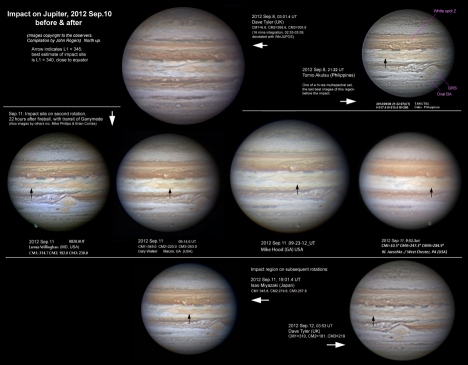

[5] Fireball on Jupiter, 2012 Sep.10.
Jupiter
in 2012/13: Report no.5
(2012 Sep.20):
Fireball
on Jupiter, 2012 Sep.10
John
Rogers (BAA)
A
bright fireball has been observed in the atmosphere of Jupiter, on 2012 Sep.10
at 11:35 UT. It was similar to fireballs observed on 2010 June 3 and 2010
Aug.20, and like them, left no detectable trace on the planet’s surface.
It
was discovered by a visual observer, Dan Petersen in Racine, Wisconsin,
observing at sunrise, who quickly notified two Jupiter contacts as follows:
“Subject:
I just observed a large explosion on Jupiter this morning!
This
morning at 11:35:30 UT I witnessed an explosion on Jupiter, it was located
at
Long1 = 335 and Lat = +12 degrees. This location at the time was just inside
Jupiter's
eastern limb and just north and inside of the
southern edge of the
NEB.
The flash was bright white in color, maybe about 6th magnitude in
brightness
and lasted for just 2 seconds. I observed this event through my
Meade
12" LX200 telescope at a power of 400X, seeing was good.”
[After
recalibrating his clock, the time was revised to 11:35:04 UT.]
Observers
worldwide were notified at once. Within
hours another amateur, George Hall in Dallas, Texas, reported the flash was
clearly visible on a video that he was recording at the time. His video has been
posted at:
http://www.flickr.com/photos/19299984@N08/7976507568/
The
video was taken through a red filter, showing the flash at approx.11:34:52 UT,
in the EZ. Although the flash
appears as multiple spots, this is partly a speckle pattern from atmospheric
turbulence, and partly a diffraction pattern from the telescope; the actual
flash would have been a point. It
appears to be brighter than mag.6, which may represent the visual impression
against the glare of Jupiter. Estimates
of the longitude have ranged from L1 = 335 (Petersen) to 345 (as marked in
Fig.2) but the adopted value, from the processed image in Fig.1, is L1 = 340,
lat. 0 deg.
Dan
Petersen’s report is a perfect model of how visual observers even now can make
and report valuable discoveries. His
estimates of position and time were pretty close for an unexpected flash only 2
seconds long, and his report enabled George Hall to find it in a video that
might otherwise have gone unexamined. The
immediacy of his report also enabled it to be used as independent data, so there
was no doubt about the reality of the fireball on Jupiter.
Scientists might not have been convinced by a single video alone,
nor by a visual report after an announcement had already been made.
Eleven
hours after the impact, observers were already looking for a visible ‘scar’.
However, none was ever seen. Figs.1
& 2 show the impact site before the fireball, and on the first four
rotations after it. The impact site
was in, or on the edge of, the orange Equatorial Band, and no changes can be
seen, except the pre-existing small blue-grey streaks drifting along it.
Images were also taken in the methane absorption band – in which impact
debris clouds look very bright – and also showed nothing. These were taken on
Sep.11 by Gary Walker (09:15 UT; see Fig.3) and Anthony Wesley (18:20 UT).
So
this impact was well characterised and left no ‘scar’. This was also the
case with the two fireballs in 2010 (see our reports, references below*).
Scientists concluded at the time that these were impacts by miniature
asteroids or comets, with diameters in the 10-metre range, which incinerated in
the atmosphere above the clouds – unlike the larger impactors in 1994 and
2009, which produced much larger, deeper explosions, converting a substantial
mass of atmospheric methane into dark soot.
The frequency of these events is in line with previous (very rough)
estimates: smaller impacts are of course more frequent than larger ones. They
are currently being observed about once a year, but because it is so easy to
overlook them, they could be occurring much more frequently (perhaps once a
month?).
*Our
reports on the fireballs in 2010:
On
our web site:
http://www.britastro.org/jupiter/2010report02.htm
http://www.britastro.org/jupiter/2010report07.htm
In
the Journal of the BAA:
Rogers
JH (2010 Oct.) JBAA 120 (5), cover & pp. 267-268: News: ‘Jupiter in
2009-2010: an interim report’, & p.263: ‘New fireball impacts seen on Jupiter’.
_________________________________
John H. Rogers, Ph.D. Jupiter Section Director,
British Astronomical Association
jhr11@cam.ac.uk
http://www.britastro.org/jupiter/